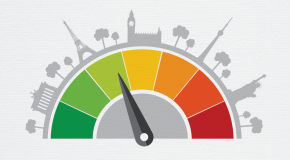One in every twenty people ever born lives right now, many of them in urban areas. With an expected 6 billion people likely to live in urban areas by 2050, the big question is: how will we engineer a smart and healthy city-environment that can accommodate all of us?
A recent study by the Organization for Economic Co-operation and Development (OECD) shows that cities are the number one energy and resource consumers, depleting 60 to 80 percent of the available energy worldwide. Under its new 2030 Energy Framework the European Commission, striving for a 40 percent greenhouse gas reduction, is very concerned because cities have become the biggest contributors to climate change on earth.
But times are changing and cities are also seen as the main drivers of innovation. Little by little a transition is taking place. There is a clear shift in mindset to exploit local resources more optimally, to increase the use of renewable energy, and to develop nearly zero-energy buildings and low energy districts. Cities understand that they have a pivotal role to play in national and global green growth strategies and they are ready for it.
How do cities keep up with these fundamental changes? And how do we protect the places where we were born; where we live and play and call our home? The answer according to famous American political advisor and author of ‘If Mayors ruled the World’, Benjamin Barber, is clear: forget about national legislators and have a closer look at our mayors; they are pragmatists and problem solvers. They play at home and are part of the neighborhood. As a result they enjoy a high level of trust.
Three quarters of carbon emissions come from cities; this means that mayors are also in the position to solve it, whether their States agree or not. And they are doing it: Los Angeles launched a concerted air pollution cleanup program in 2006 achieving an unprecedented 79 percent drop in diesel particulate emissions today. In December 2013 New York City released a statement declaring that it had reduced its greenhouse gases by 19 percent since 2005 due to cleaner generation of electricity and steams and increased energy efficiency in buildings.
In less than ten years Singapore managed to develop a city-state for its 5.2 million people known as the Green Lung of Asia, helping attract vast numbers of foreign investors for its high quality lifestyle. McGraw Hill Construction’s World Green Building Trends Report found that Singapore, with its critical energy consumption on the rise (93% versus 73% in the other Asian countries), was one of the first few countries in the world to introduce the BCA Green Mark rating system, a tool to evaluate a buildings’ environmental and energy performance, in 2005. The ambitious goal was to have at least 80 percent of the city-state’s buildings certified by 2030. Today 21% has already been achieved. Thanks to Singapore’s safe, reliable and well balanced metro and bus system, using solar panels to replace fuel based energy wherever possible, and with local market leaders such as City Development Limited, committed to sustainability and bringing more green buildings into the world, this city-state has become a sustainable role model for the rest of the Asian region.
Closer to home, Barcelona is working hard on six strategic initiatives: Smart Lighting, Smart Energy, Smart Water, Districts Heating and Cooling, Smart Transportation and Zero Emissions mobility. With 50% of Barcelona’s lighting power today being remotely controlled and main parts of the parks and green spaces managed through remote irrigation; the city already improved the efficiency and quality of life of its residents . And the City of London, generating 8.5 percent of the country’s total carbon emissions, launched two years ago an important climate and energy strategy, including plans to adapt London’s homes with energy efficiency measures, retrofitting public sector buildings and launching pilot projects to create multiple low carbon zones. In Europe many cities today are competing to become the world reference in Smart Cities showing the entire world that there is the will to build a healthier, more efficient, greener and more prosperous future for our cities.
Cities change and take the lead because they have to; our population has exploded and the urban regions need to pick up the strain. Politicians, mayors, public administrations, small and medium sized enterprises, all begin to see the many opportunities for creating innovative solutions for cities around the world. Smart Cities is not something futuristic or make believe; it has become a necessity. If managed well, this will certainly affect our economies and the way we will live and work in a positive way.
Let’s just not forget that cities are not only about buildings, grids and roads. They are about something much more important than that: they are all about us.




